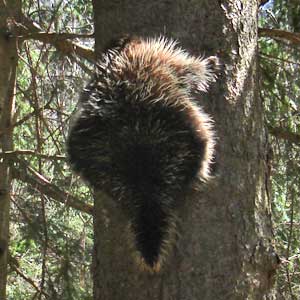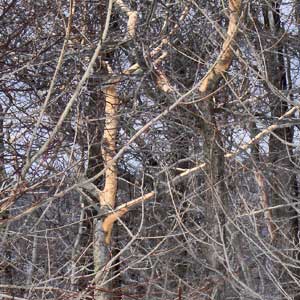Porcupines are the second largest rodent in North America behind the beaver. They are herbivores. In the summer they prefer water lily and arrowhead. In the Winter they like Hemlock bark. In the Spring they like maple tree bark. They are typically a slow moving animal with 30,000 needle sharp barbs. Their primary predator is a Fisher. But, they are also preyed upon by Bobcats, coyotes, foxes, bears, and the Great-Horned Owl. They are solitary most of the year, and they do not hibernate.
Porcupines in the Catskill Mountains range in weight from 10-to-35 pounds. Their body length ranges from 24-40 inches long (excluding the tail). The tail is usually 8-to-10 inches long. The tail is muscular and used for defense and climbing. If you were to remove all the quills from a porcupine, the body of the porcupine would like very similar to a black bear. Porcupines come in variety of shades. Brown, black, and grey are the most common. White is rare. Procupines are nocturnal. But, can find them foraging for food during the day. Especially in the Winter. Porcupines are near sighted. Porcupines live 5-6 years in the wild, and 10 years in captivity.
The quills of a porcupine cover their entire body except for their face and underbody. There are over 30,000 quills on an average porcupine. The quills are hollow, and this helps them float in the water when they swim after one of their favorite food sources: Water lilies. The quills have reverse direction barbs, which make them difficult to remove. When the quills is impaled into a predators body it causes it to swell up, and makes it more difficult to remove. They are usually dark on the barbed end, and white on the shaft. One myth that has been told for years is that porcupines can shoot quills. This is not true. What is true is that a porcupine can shake their tails violently, and this causes quills to fly off the shaking tail. The quills on a porcupine face backwards from the head. If the porcupine is scared, it will use it's muscles to force the quills to face directly upwards. Quills have a small amount of antibotics on them. Most impalements do not cause an infection, but this does not prevent infections from occuring. Procupines can stick themselves with their own quills from time-to-time. They are excellent at removing these accidents. The quills on porcupines can have different lengths. It depends on where on the body they grow. They are the longest on the lower back and tail. Any quills that are lost will grow back. One of the biggest dilemmas is how do porcupines give birth to babies with quills. Quills of newborn porcupines are actually soft, and will harden within hours after giving birth. They are born with a full coat of quills.
Porcupines prefer conifer trees, and specifically Hemlock trees in the Catskill Mountains. But, they will also live in spruce and pine forest. They will also live in deciduous and mixed forest. They can be found foraging on the forest floor or high up in a tree. While they are good climbers, they do fall out of trees often. If they break bones from a fall, they heal quickly.
In the Summer months porcupines will live at a higher altitude in the mountains. They will move up to a mile from their den. But, in the Winter months porcupines will move to lower altitudes. They will move less then 300 feet from the den during the Winter. Porcupines will den together with other porcupines in the Winter. They do so for food and survival, and not for social reasons. But, in the Summer months they are solitary, and will den alone. Porcupines do not hiberate in the Winter. Their dens can be tree cavities, in rock piles, caves, under openings in ledges, crevices, hollow logs, under hollow sections of tree root bulbs, under large rocks, or even under buildings. Porcupines will lose approximately 17% of their body weight during the Winter months. But, if snow depths increase attrition can cause greater loses.
In the Summer porcupines prefer aquatic plants like water lilies. They will also eat budding tree leaves. This type of diet is high in potassium, and will cause them to lose sodium. This causes them to search for salt. They find salt on roads in the Spring, plywood, car tires, tool handles, etc. Back in the 1800's porcupines would eat holes in the side of homes to pursue salt. Hikers have reported porcupines licking their skin while sleeping. They will become obsessed with finding salt. In the summer and Fall they will also seek out nuts. If the year is good for acorn crops, you can find them eating acorns. In the Winter, they will climb trees and eat the bark off of trees. In the Winter, you can find their tracks by the half piped shaped trail in fresh snow as they drag their body thru it. In the summer months the range is 25-35 acres. In the Winter months the range is 6-12 acres. Porcupines eat a little less then a pound of food per day. The digestive tracks of porcupines consist of 75% of porcupines body. Porcupines must eat hard materials to keep their teeth to a proper shape. Their teeth will grow 12 inches per year. Tree bark helps wear down their teeth. They will also eat deer antlers to wear down their teeth. You would think that porcupines are expert tree climbers, but they do fall out of trees quite often. Sometimes, they will break bones and become injuried during the fall. But, their bones heal quite quickly.
Porcupines breed in around November in the Catskill Mountains. The gestration ranges between 205-to-217 days. They usually give birth to one young porcupine. They usually weigh about 1 pound. They are born with soft quills, which harden within hours. They usually become weaned within 3 months, and independent within 6 months. They will start breeding between 15-and-18 months.
|
 |
 |
 |
Porcupine climbing a tree
In a defensive posture. |
 |
 |
 |
Porcupine climbing a tree
In a defensive posture. |
 |
 |
 |
Porcupine climbing a tree |
 |
 |
 |
Tree bark eaten by a Porcupine
Den will be close by |
|

